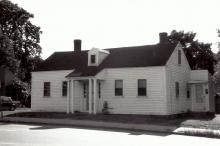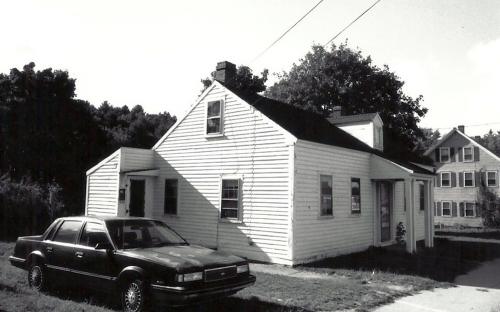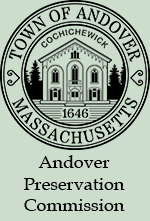Architectural Description:
Cape style cottage used for Marland Mill operatives
Historical Narrative:
Abraham Marland established a cotton mill in 1807 on the Shawsheen River at Abbott Village, which continued until 1811 when he began production of woolen goods. In 1821 “Marland leased from Peter C. Brooks of Boston a mill privilege on the Shawsheen, together with new buildings erected on the site of what had been a powder mill. This are is now known as Marland Village. Abraham Marland built his homestead estate at 29-33 Shawsheen Rd. The buildings, which were leased for a term of twenty years, comprised a brick mill, the oldest of the present buildings at Artia Marland Place, and a row of brick tenement houses.”
In 1828 Marland bought the entire property, his purchased including the mill privilege, old paper and grist mills, and thirty acres of Land. In 1834 the business was organized under the name Marland Manufacturing Company. Abraham Marland was the president until his death on Feb. 20, 1849.
Nathan Frye succeeded Marland as the company president from 1849-1879.
The company defaulted on an 1873 loan from the Andover Savings Bank and the mill was sold at auction to Moses T. Stevens on North Andover in 1879. Stevens began improvements at the mill in 1884 relocating the road, building a causeway across the mill pond, a new bridge, and additional operative housing on North Main Street and Stevens Street.
August 8, 1884 Andover Advertiser, pg. 2 col 7 –
“For several years past the Marland factory has been undergoing changes and improvements, and the erection of new tenement houses, store houses, and other convenient buildings, until it has become one of the neatest and tidiest factory villages in New England.
Passing down Main street towards Frye Village, the attention of the traveler is attracted to the snowy whiteness of the tenement blocks, on the left hand of the great thoroughfare, each having a beautifully embellished flower patch in the front yard. Everything in and about the buildings betokening good taste and much painstaking. But we did not intend so much to notice what has been done, as what is now doing, and the new departure has been entered upon.
This time a new avenue from Main street to Marland street (Stevens St. today), on the west side of the river, about 150 feet south of the dam. This will make a saving of the distance traveled of 250 feet.
The plans were made by Richard A. Hale, Civil engineer of Lawrence. Excavating and building of stone flume, by Henry Keniston of North Andover. Millwork and Piling by James P. Butterfield of Andover. Stone from Lawrence Ledge, furnished by Jessie Moulton. Dimensions of bridge, 40 feet long, 22 feet wide, with 5 foot sidewalk on one side. Made by Boston Iron Bridge Company, Plate Girder Bridge.
Whole length of bridge and roadway is 280 feet. Roadway across pond 30 feet wide; 390 feet from Marland street, near turnpike, to proposed roadway across pond; 1500 perch of stone, and 1200 yards of filling required. The walls of the bridge at the bottom are 5½ feet thick, at the top 3½ feet thick, 14 feet high.”
Stevens Street was formerly known as Marland Street prior to 1904. This street is an ancient way in Andover and predates Main Street, originally called the “Essex Turnpike”, constructed in 1806-1811. Before the Main Street construction, travelers went down School Street to Central Street to Elm Square, then turned down Essex Street to Shawsheen Rd., then down Stevens Street passing through the Marland Mill complex, (Atria Marland Place entrance and driveway), then turning right across the bridge on to Harding Street which then extended through the parking lot behind Powder Mill Square to the North Main Street intersection. Turning left on No. Main and across Stimpson’s Bridge to Poor Street which once began at the site of the Christian Scientist Church and traveled north to the Andover Bridge at the Great Dam in Lawrence.
In 1896 the Marland Mill operation, now M. T. Stevens & Sons, Co. , employed 200 operatives and manufactured 875,000 lbs. of wool yearly. The company later became known as J. P. Stevens & Co. Inc. after World War II.
In 1953 the J. P. Stevens Co. divested itself of all its housing stock in Marland Village which was then subdivided into separate parcels and sold to public residents. Approval of the subdivision plans #2619 and #2020 by the Andover Board of Appeals occurred in Nov. 1952. All the properties on North Main Street were sold to private parties in 1953.
Alice G. (Hilton) Richardson purchased the property on Apr. 22, 1953. It was then placed in her name and sister Elizabeth M. Hilton. [see 188 North Main St. for Hilton home.] In 1953 the house was rented to Eva Walsh age 61 and operative at Marland and the other side to John & Frances Strout. John was 65 and a loom fixer. In 1990 the house is occupied by John J. Guen, a printer. who was there until 1993. The right side of the house is occupied by Jeffrey D. Sasek, a driver, and the last occupant of the house in 1995. In 1996 all the houses from #188 to here are vacant. The house was razed in 2004 for the construction of Powder Mill Sq. and building A or #1 on the site.
Bibliography/References:
Essex County Registry Deeds, Salem, MA
Essex Northern Registry Deeds, Lawrence, MA
Andover Advertiser AA
Historical Sketches of Andover, S. Bailey 1880
Business History of Andover, 1896 Anniversary Souvenir.
Andover Historical Society files.
Andover Valuation and directories
Owners;
Peter C. Brooks
Abraham Marland – 1828 - Feb. 20, 1849
Marland Manufacturing Co., Abraham Marland Pres., - 1834 - 1849
Marland Manufacturing Co., Nathan Frye, Pres. – Feb. 1849 - July 19, 1879
Moses T. Stevens Co. July 19, 1879 – b. 56 p. 482
M. T. Stevens & Sons Co. – Sept. 1, 1902 – b. 197 p. 180
J. P. Stevens & Co. Inc. – after 1946
Alice G. Richardson - Apr. 22, 1953 - b. 774 p. 526
Alice G. Richardson & Elizabeth M. Hilton - Apr. 22, 1953 - b. 774 p. 528
Inventory Data:
| Street | North Main St |
| Place | Marland Village |
| Historic District | Andover Village Industrial NRH District |
| Historic Name | Marland Mills Worker Housing |
| Present Use | Powder Mill Square condominiums |
| Original Use | Mill worker housing |
| Construction Date | circa 1821-1830 |
| Source | ERDS, ENRDL |
| Architectural Style | Federal |
| Foundation | stone & granite |
| Wall/Trim | clapboard/wood |
| Roof | asphalt |
| Condition | razed 2004 |
| Demolition Details | 2004 |
| Setting | residential/commerical |
| Map and parcel | 37-24 |
| Recorded by | Stack/Mofford, James Batchelder |
| Organization | Andover Preservation Commission |
| Date entered | 1975-77, 8/2014 |




